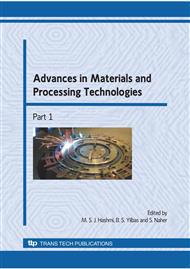[1]
D. Zulli, R. Alaggio and B, Francesco, Flexural-torsional post critical behavior of a cantilever beam dynamically excited: Theoretical model and experimental tests, Proceedings of the 2003 ASME Design Engineering Technical Conferences and Computers and Information in Engineering Conference. Vol. 5: 19th Biennial Conference on Mechanical Vibration and Noise (2003).
DOI: 10.1115/detc2003/vib-48597
Google Scholar
[2]
P. Qiao, Z. Guiping and J. F. Davalos: Flexural-torsional buckling of fiber-reinforced plastic composite cantilever I-beams, Composite Structures, Vol. 60, No. 2 (2003), p.205.
DOI: 10.1016/s0263-8223(02)00304-5
Google Scholar
[3]
S. K. Parashar, U. Von Wagner and P. Hagedorn: A modified Timoshenko beam theory for nonlinear shear-induced flexural vibrations of piezoceramic continua, Nonlinear Dynamics, Vol. 37, No. 3 (2004), p.181.
DOI: 10.1023/b:nody.0000044678.78930.cb
Google Scholar
[4]
M. Palacz, M. Krawczuk and W. Ostachowicz: The spectral finite element model for analysis of flexural-shear coupled wave propagation. Part 2: Delaminated multilayer composite beam, Composite Structures, Vol. 68, No. l (2005), p.45.
DOI: 10.1016/j.compstruct.2004.02.013
Google Scholar
[5]
F. Liu and F. Xi: Dynamic response of elastic-plastic curved cantilever beam subjected to projectile impact at its tip with consideration of large deflection, Zhendong yu Chongji/Journal of Vibration and Shock, Vol. 25, No. 1 (2006), p.118.
Google Scholar
[6]
H. Salarieh and M. Ghorashi: Free vibration of Timoshenko beam with finite mass rigid tip load and flexural-torsional coupling" International Journal of Mechanical Sciences, Vol. 48, No. 7 (2006), p.763.
DOI: 10.1016/j.ijmecsci.2006.01.008
Google Scholar
[7]
P.F. Rizos, N. Aspragathos and A.D. Dimarogonas: Identification of crack location and magnitude in a cantilever beam from the vibration modes, Journal of Sound and Vibration, Vol. 138, No. 3 (1990), p.381.
DOI: 10.1016/0022-460x(90)90593-o
Google Scholar
[8]
S.R. Abdulsalam: On the dynamical behavior of an uniform cantilever beam of variable length, Proceedings of the Tenth International Congress on Sound and Vibration, Jul 7-10 (2003), p.523.
Google Scholar
[9]
S. Papargyri-Beskou, D. Polyzos, and D. E. Beskos: Dynamic analysis of gradient elastic flexural beams, Structural Engineering and Mechanics, Vol. 15, No. 6 (2003), p.705.
DOI: 10.12989/sem.2003.15.6.705
Google Scholar
[10]
S. Suresh, S.N. Omkar, R. Ganguli, and V. Mani: Identification of crack location and depth in a cantilever beam using a modular neural network approach, Smart Materials and Structures, Vol. 13, No. 4 (2004), p.90.
DOI: 10.1088/0964-1726/13/4/029
Google Scholar
[11]
M. Li, and Z. He: The self-damping characteristics of a magnetic constrained fully covered sandwich cantilever beam, Transactions of the Canadian Society for Mechanical Engineering, Vol. 29, No. 3 (2005), p.333.
DOI: 10.1139/tcsme-2005-0020
Google Scholar
[12]
C. Kimball and L-W. Tsai: Modeling of flexural beams subjected to arbitrary end loads, Journal of Mechanical Design, Transactions of the ASME, Vol. 124, No. 2 (2002), p.223.
DOI: 10.1115/1.1455031
Google Scholar
[13]
L. Shan, and P. Qiao: Flexural-torsional buckling of fiber-reinforced plastic composite open channel beams, Composite Structures, Vol. 68, No. 2 (2005), p.211.
DOI: 10.1016/j.compstruct.2004.03.015
Google Scholar


